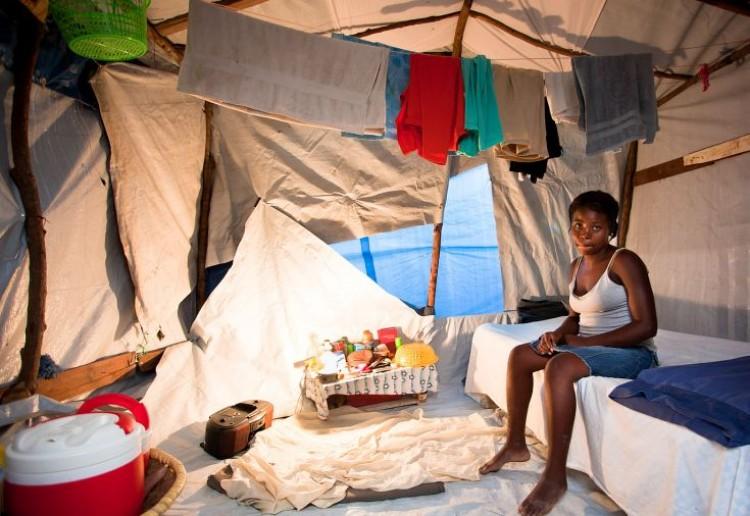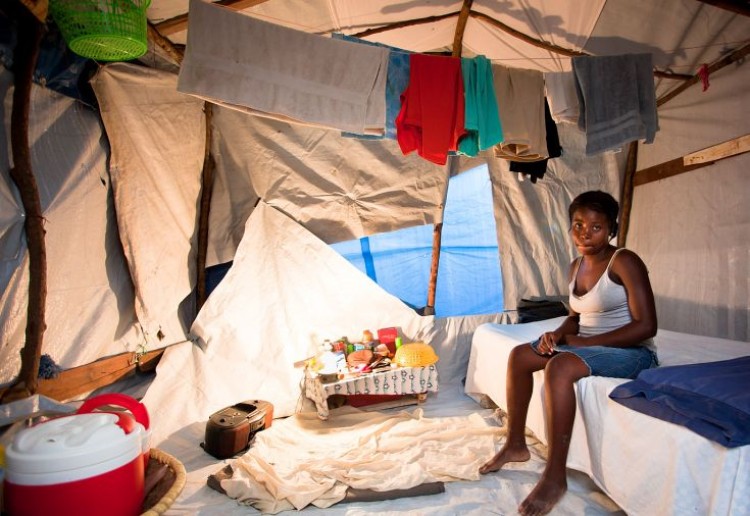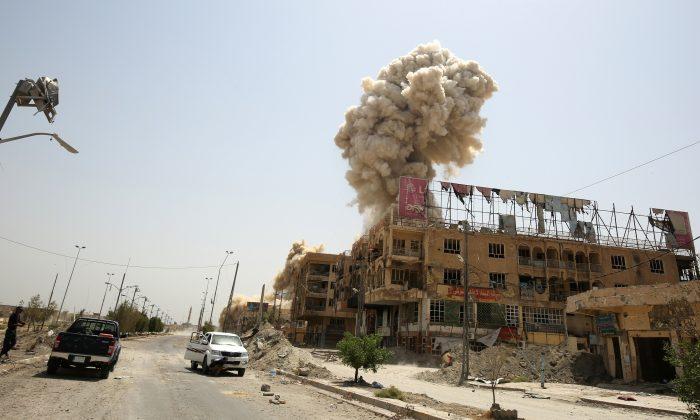In the book Tent Life: Haiti, photographer Wyatt Gallery attempts to capture the lives of people in Haiti in the aftermath of the devastating January 12, 2010 earthquake. The book is part photography project, part charity endeavor—100 percent of the royalties go toward three Haitian organizations: J/P Haitian Relief Organization, Healing Haiti, and the Global Syndicate.
Many of the photos throughout the pages of the book were taken inside or in front of tent homes that were meant to be temporary shelters for some of the 1.5 million Haitians displaced by the 7.9 magnitude earthquake. The human subjects range from children to elderly Haitians, many of them head-to-toe shots that show people walking barefoot through mud and trash. These photos reveal to the reader the resilience of the Haitian people amidst their extreme poverty.
There are also several panoramic shots of the shelters, which provide the reader with some perspective on the enormous size of these tent cities of Haiti.
Although Gallery makes an admirable attempt to depict the Haitians living in tent camps in a humane and positive light, his photographs somehow fall short of being engaging, striking, or moving. Many shots are densely shadowed, some to the point where the people’s faces cannot be seen clearly.
More importantly, many of the photos taken inside the camps leave the viewer at a distance from the subjects of the photographs, whether structural or human. In short, the overall effect of Gallery’s photographs fails to convey a strong sense of environment or make a solid human connection for the reader.
Ironically, one of Gallery’s most striking photographs in the book is not of people living in tents, but the ruins of the Cathedral of the Lady of the Assumption. He effectively shows the former splendor of the building juxtaposed against its crumbled ruins. In that photograph, although it is a building, Gallery deftly succeeds at depicting both a victim and a survivor.
Tent Life: Haiti was published in April 2011 and includes 74 color photographs, Gallery’s journal entries of his personal experiences in Haiti, a historical timeline of the country, and an essay by famed Haitian-American novelist Edwidge Danticat.
The book is instructive for anybody wishing to catch a glimpse of what life is like for many of the survivors of the earthquake. It is also a worthwhile way to support charitable organizations that are working to rebuild Haiti and help the people there. But overall, the book is lacking in emotional impact, and comes across mostly as an ambitious, but unfulfilled project.
Many of the photos throughout the pages of the book were taken inside or in front of tent homes that were meant to be temporary shelters for some of the 1.5 million Haitians displaced by the 7.9 magnitude earthquake. The human subjects range from children to elderly Haitians, many of them head-to-toe shots that show people walking barefoot through mud and trash. These photos reveal to the reader the resilience of the Haitian people amidst their extreme poverty.
There are also several panoramic shots of the shelters, which provide the reader with some perspective on the enormous size of these tent cities of Haiti.
Although Gallery makes an admirable attempt to depict the Haitians living in tent camps in a humane and positive light, his photographs somehow fall short of being engaging, striking, or moving. Many shots are densely shadowed, some to the point where the people’s faces cannot be seen clearly.
More importantly, many of the photos taken inside the camps leave the viewer at a distance from the subjects of the photographs, whether structural or human. In short, the overall effect of Gallery’s photographs fails to convey a strong sense of environment or make a solid human connection for the reader.
Ironically, one of Gallery’s most striking photographs in the book is not of people living in tents, but the ruins of the Cathedral of the Lady of the Assumption. He effectively shows the former splendor of the building juxtaposed against its crumbled ruins. In that photograph, although it is a building, Gallery deftly succeeds at depicting both a victim and a survivor.
Tent Life: Haiti was published in April 2011 and includes 74 color photographs, Gallery’s journal entries of his personal experiences in Haiti, a historical timeline of the country, and an essay by famed Haitian-American novelist Edwidge Danticat.
The book is instructive for anybody wishing to catch a glimpse of what life is like for many of the survivors of the earthquake. It is also a worthwhile way to support charitable organizations that are working to rebuild Haiti and help the people there. But overall, the book is lacking in emotional impact, and comes across mostly as an ambitious, but unfulfilled project.








Friends Read Free